许村国际艺术公社,和顺,山西,中国
建筑设计:渠岩/中国艺术乡建研究院
许村国际艺术公社,和顺,山西,中国
建筑设计:渠岩/中国艺术乡建研究院

1 外景/Exterior views
许村国际艺术公社在许村东部的艺术家广场内,包括创作中心、展示中心、艺术家工作室、艺术图书馆、新媒体中心、陶艺工作坊、山西民间艺术研究基地以及艺术家休息的乡村酒吧与餐馆等。
许村国际艺术公社大都由被闲置和废弃的旧影视基地和传统老屋改建。既保留了传统建筑的外观,又重新改造和调整了内部空间与设施,让它既保留了传统建筑的原貌,又具有现代生活的使用功能、舒适和方便。就是想让村民看到在老房子的形态里,同样能过上现代化的舒适生活。改造好之后很多村民就非常惊奇,感觉他们熟悉的老房子怎么能做得这么有意思,这也给他们一个对自己的老房子重新审视的机会和思考。
这栋建筑有当地传统的走廊入口,中心庭院还有后院。围绕中心庭院布局房间,并用材料、光等要素定义并呈现现代生活的景象。建筑在关怀环境、联系呈现各历史时期架构的同时,还希望带来全新的当代生活,通过尊重建筑大环境和谨慎的使用当地建筑元素,满足生活功能,挑战限制,定义出具备新意义和更多活力的全新空间。
许村国际艺术公社完全被美丽的太行山环抱,由传统建筑改造成的当代艺术空间,被誉为中国乡村版的“798”。这里既能为来自世界各地的艺术家在中国传统文化的腹地带来惊喜和启发,也能激发创作者与自然的深层交流。又能为当地居民带来新的世界观和生活方式。同时也期待将国际的当代艺术理念深耕于中国传统文化的土壤中,以及和当地社群共同创造生态、艺术与社会的对话现场,提供艺术家一个社会与人文关怀相结合的创作空间。
许村国际艺术公社也积极邀请当地的艺术爱好者、村民与团体参与创作过程,从而增进艺术与当地村民的彼此理解与交流,让鲜活生动的艺术创意在古老的村落生根开花,并为这座古老的山村以及和顺地区注入新鲜的文化活力。艺术公社将定期地举行各种国际艺术创作活动、国际艺术家驻村创作计划、青年艺术家扶植计划。以艺术村的形式提供跨国及多元化的艺术合作平台,促进各国艺术家之间的艺术交流与创作,促进跨文化跨领域的对话,促进本地区的文化知名度与文明的提升,传达人与自然、人与艺术之间的无限可能性的艺术实践。
许村不仅有艺术家,还有世世代代在此生活的农民,他们与来自世界各地的艺术家一起,给太行山下的小山村带来了微妙与和谐的碰撞。往昔的古老山村经过时代岁月的浸染,成为了中外文明并独具特色的国际艺术村,惬意的生活在此时倾注,都市的喧嚣在这里沉寂。简朴的农舍散发出艺术与灵气。社会的浮躁无法干扰许村的宁静,在宁静中又不失艺术焕发的活力,这种重新焕发的乡村精神在时代中穿梭,许村不但成就了在地艺术家的人生瞬间,也使这个古老的乡村在新的时空中浴火重生。
Xucun International Art Commune is located in the Artist's Square in the east of Xucun Villiage. It consists of Arts Creation Center, Exhibition Center, Artist’s Studio, Art Library, New Media Center, Pottery Workshop, Shanxi Folk Art Research Base and country bars and restaurants.
Xucun International Art Commune is mostly a renovation of an abandoned film base and some desolated traditional houses. It has not only retained the appearance of traditional buildings, but has also transformed and adjusted the internal spaces and facilities, producing the coexistence of the image of traditional buildings and the functions needed for the convenience of modern life. It enables the villagers to enjoy a comfortable modern life in a house with the old appearance. Many villagers are surprised at the transformed building. They cannot have imagined such an amazing change, which give them a chance to review and think about their old houses.
This building has a traditional corridor entrance and a central court with a back yard. The rooms are arranged around the central court with the elements of materials and lights to define and picture modern life. The architecture caters to the current environment, presents all the structures of different historical periods and at the same time brings a brand new modern way of life. With respect for the overall architectural environment and prudent use of local architectural elements, it aims to meet the requirements for modern life, to challenge limits and define an entirely new space with new meanings and more vitality.
Xucun International Art Commune is surrounded by the beautiful Taihang Mountain. Transformed from traditional buildings into a modern art center, it is regarded as the country version of 798 Art Zone. It does not only bring surprise and inspiration to artists from all over the world in the hinterland of Chinese traditional culture, but also stimulates deep communication between the artists and the nature. It displays a new vision of the world and a new way of life for the local residents. At the same time, it hopes to root the international contemporary art concepts deep in the soil of the Chinese traditional culture, creating an ecological, artistic and social dialogue scene jointly with the local community and provide artists with a creative space with social and humanistic concerns.
Xucun International Art Community has also actively invited local art lovers, villagers and organizations to participate in the creation process, to promote mutual understanding and communication between the local villagers and the artists, to let lively artistic ideas take root and blossom in the village, and to inject fresh cultural vitality into this ancient region. The commune regularly holds various international artistic activities, carries out international visiting artist programs and plans for nurturing young artists. A transnational art platform in form of the art village will be established to promote art exchange between artists from different countries, strengthen crosscultural interdisciplinary dialogues, promote the culture and civilization of the local region, and convey unlimited possibilities for art practices between human and nature as well as between human and arts.
Xucun Village has not only artists, but farmers who have been living here from generation to generation. They work together with artists from all over the world, bringing subtle and harmonious collision to this small village at the foot of Taihang Mountain. The ancient village, having been imbued with arts for many years, has become a unique international art village, where the coziness of life silences the hustle and bustle of the city. The simple cottage gives off the scent of arts. Immune to the fickleness in modern life, Xucun Village remains in peace without losing its vigor in arts. This renewed spirit traverses in times. Xucun Village does not only ignite remarkable moments of life for the local artists, but also makes itself reborn in the new era.

2 外景/Exterior views
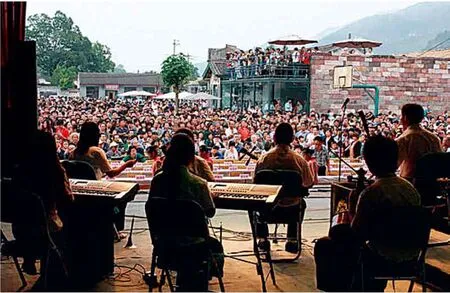
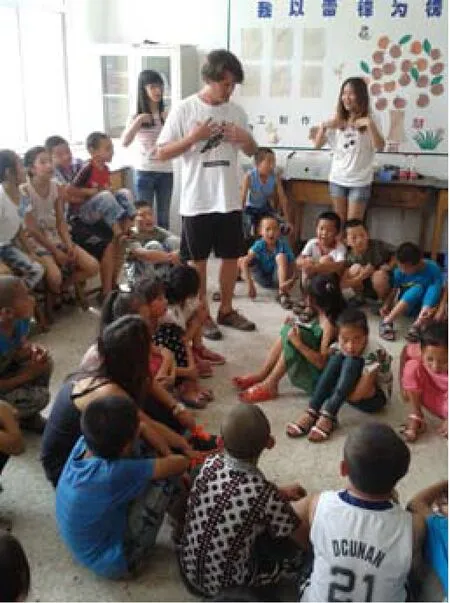
3.4 艺术节/Art festival
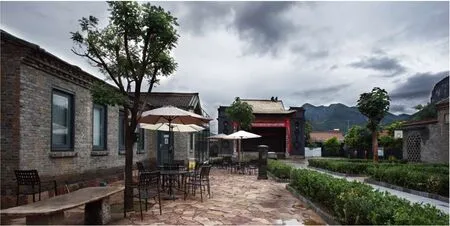
5 外景/Exterior view
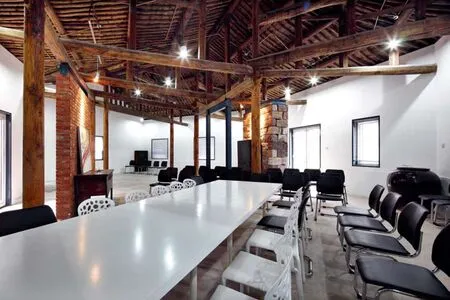
6 内景/Interior view
项目信息/Credits and Data
主持建筑师/Principal Architects:渠岩,郭建华/QU Yan, GUO Jianhua
客户/Client:许村国际艺术公社/Xucun International Art Community
设计团队/Design Team:中国艺术乡建研究院/Chinese Art Village Building Research Institute
功能/Program:国际艺术交流/International Art Communication场地面积/Site Area:3000m2
建筑面积/Floor Area:1000m2
建筑材料/Materials:砖,红砂岩/Brick, red sandstone
设计时间/Design Period:2011
摄影/Photos:王笑飞/WANG Xiaofei

7 平面/Floor plan
评论
罗德胤:创新要自下而上,风尚要自上而下。古老的村庄,化身为国际的、艺术的村子,自然就具备风尚的因子了。 尽管从设计手法而言,钢和玻璃的使用让这里的新旧反差略显过头,但是新时代的精英还乡模式还是让许村足以成为乡村保护与建设的先锋。
董卫:20世纪初,我国曾经有一次十分重要的乡村建设运动,许多学者、文人和官员都开展研究与实验,为乡村发展作出了贡献。其中晏阳初的“定县实验”与费孝通的“江村经济”影响深远。而阎锡山在山西的乡村治理规模更大,涉及范围更广,但他提出的“村本政治”因理想与实践脱节而归于失败……约100年以后的今天,乡村发展再次成为国人关注的话题,所不同的是,今天的乡村发展已经上升为一种国家战略。如果我们将这一变革置于社会经济转型的大势之中,就可以理解,现在正是各种有益的探索都值得开展、也值得鼓励的时代。以艺术引领乡村发展,是山西许村国际艺术公社的特点和亮点,一批特定的人群以对传统文化的热爱和对奉献家乡的执着,通过国际化的艺术活动为乡村发展点亮一盏指路明灯,开辟一条前行的道路,的确引人注目。显而易见,许村的实验是很有价值的,同时也是不易复制和普及的。因此,除了目前我们所见到的成果外,许村的发展还期待更为持久的推动力和更为深刻的社会经济变革。或许人们会问,这种国际艺术公社是一种可能的乡村改造模式吗?回答就是:是,也不是。而阎锡山在山西的乡村治理规模更大,涉及范围更广,他的“村治实践”名噪一时,或可作为本案一个长长的历史前奏?
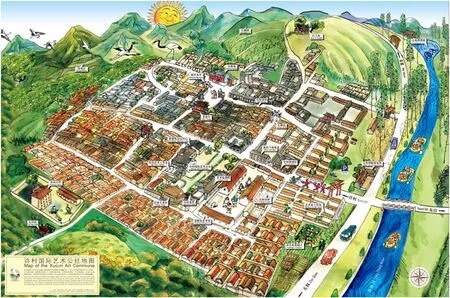
8 草图/Sketch
Comments
LUO Deyin: Innovation should come from the bottom up, while fashion should go from the top down. An ancient village, when transformed into an international and artistic village, is naturally equipped with fashion factors. In terms of the design techniques, the use of steel and glass a bit overemphasized the contrast between the new and the old. However, this elite-returning-hometown model in the new era is enough to make Xucun Village a pioneer in the field of village protection and construction.
DONG Wei: In the early 20th century, there was an important Rural Reconstruction Movement in China. Many academics, scholars, and officials participated in it by carrying out researches and experiments to promote rural development, among which "Dingxian County Experiment" by Y.C. James Yen (YAN Yangchu) and "Jiangcun Village Economy" by FEI Xiaotong were of far-reaching impact. The rural governance by YAN Xishan in Shanxi Province covered a much larger area with bigger impacts, although his "Village Autonomy" failed eventually due to the disconnection between the ideal and the actual practice... Nowadays, about 100 years later, rural development once again becomes a topic of great concern. Different from the past, the present rural development has become a national strategy. To position this reform in the context of the current socio-economic transformation, it can be understood that now is the time to encourage and carry out a variety of meaningful explorations. The uniqueness and the highlight of Xucun Village International Art Commune in Shanxi Province is the fact that art was leading the rural development. A certain group of people committed to traditional culture at their hometown creates a new path for the rural development by means of international art activities, which is indeed impressive. Apparently, the experiment at Xucun Village is valuable, but it is hard to be copied in other places. Therefore, besides the existing achievements, Xucun Village is looking for a more sustaining impetus and more profound social and economic transformation for further development. People may wonder whether this international art commune is a possible model for rural transformation, and the answer is "Yes, and No". The above mentioned "Village Autonomy" by YAN Xishan in Shanxi Province maybe considered as a prelude to this project?
Xucun International Art Community, Heshun, Shanxi, China, 2011
Architects:QU Yan/Chinese Art Village Building Research Institute

